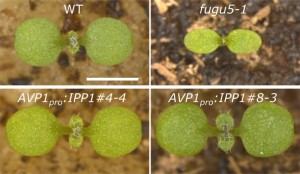Keep an Eye on PPi The Vacuolar-Type Proton-Pyrophosphatase Regulates Postgerminative Development in Arabidopsis

Pyrophosphate (PPi), being toxic to the cell itself at high levels, is efficiently hydrolyzed by enzymes called pyrophosphatases (PPases). In plants, unlike animals or yeast, there are no cytosolic PPases, instead a unique vacuolar membrane bound H+-PPase is responsible for PPi degradation and vacuole acidification as well. A previous report claimed that the latter function, namely the vacuolar acidification, is the major role of this PPase.
Here, we discovered that upon seed germination, seedlings of the H+-PPase defective fugu5 mutant failed to produce sucrose from lipid stores due to high cytosolic PPi, which is released by active metabolism in germinating seeds. The addition of sucrose or specific removal of cytosolic PPi in the fugu5 mutant, by the expression of the yeast cytosolic PPase IPP1, rescued both cellular and morphological phenotypes of fugu5 (Figure 1). Therefore, in contrast to the previous belief that favored a major role of plant H+-PPase as a proton pump, here we suggest based on solid evidence, that the removal of PPi is the central role of the plant H+-PPase.
Importantly, the growth of the transgenic lines was significantly improved (AVP1pro:IPP1; Figure 1 bottom panels), suggesting that the IPP1 gene may represent a powerful tool for genetic engineering of plants with higher yield and increased biomass production.
Paper
Ali Ferjani, Shoji Segami, Gorou Horiguchi, Yukari Muto, Masayoshi Maeshima, and Hirokazu Tsukaya,
“Keep an Eye on PPi: The Vacuolar-Type H+-Pyrophosphatase Regulates Postgerminative Development in Arabidopsis”,
The Plant Cell published online on 29 August 2011.(Japan time)
Article link (Publication)







